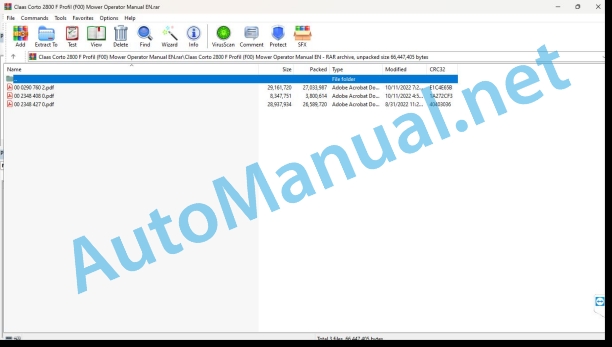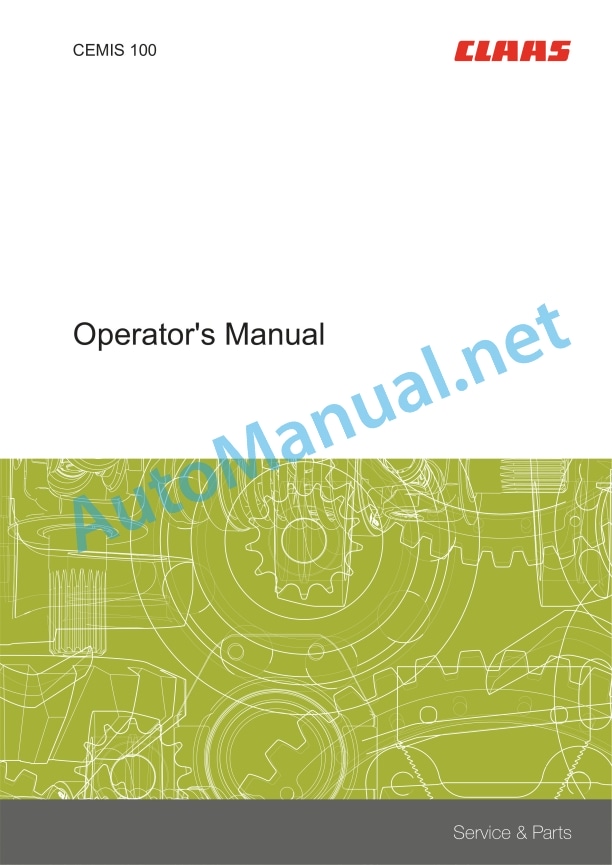Claas Corto 2800 F Profil (F00) Mower Operator Manual EN
$50.00
- Model: Corto 2800 F Profil (F00) Mower
- Type Of Manual: Operator Manual
- Language: EN
- Format: PDF(s)
- Size: 54.8 MB
File List:
00 0290 760 2.pdf
00 2348 408 0.pdf
00 2348 427 0.pdf
00 0290 760 2.pdf:
CORTO 3200 FN ProfilCORTO 3200 F ProfilCORTO 2800 F Profil
Table of contents
1 To this operator’s manual
1.1 Notes on the manual
1.1.1 General instructions
1.1.2 Using the manual
Directions
1.1.3 Validity of manual
1.1.4 Symbols and notes
1.1.5 Technical specifications
2 Safety
2.1 Safety rules
2.1.1 Particularly important
2.1.2 Qualification of drivers and maintenance personnel
2.1.3 Intended use
2.1.4 Reasonably foreseeable misuse
2.1.5 Safety and accident prevention regulations
2.1.6 First aid measures
2.2 Safety decals on the machine
2.2.1 Safety decals
2.2.2 Position of hazard warning signs
3 Machine description
3.1 Overview and method of operation
3.1.1 Overview of CORTO 3200 F Profil / CORTO 3200 FN Profil / CORTO 2800 F Profil
3.1.2 Functions
3.2 Optional equipment
3.2.1 Additional swathing discs*
3.2.2 Three-point extension*
3.2.3 Hydraulic front load relief
3.2.4 Hydraulics kit – AXION 800 with 5 tons lifting unit*
3.2.5 Hydraulically folding safety frames*
3.2.6 Glide disc height increase for high-cut operations*
3.2.7 Spacer rings for high-cut operations*
3.2.8 Catch belts*
3.2.9 Legal equipment for France*
3.3 Identification plates and vehicle identification number
3.3.1 Machine identification plate
3.4 Information on the machine
3.4.1 Decal
4 Operating and control elements
4.1 CORTO 3200 F / CORTO 3200 FN / CORTO 2800 F
4.1.1 Controls and indicators
5 Technical specifications
5.1 CORTO 3200 F / CORTO 3200 FN
5.1.1 Dimensions
5.1.2 Weights
5.1.3 Requirements for the tractor
5.1.4 Version
5.1.5 Sound pressure level
5.1.6 Operating utilities and filling quantities
5.2 CORTO 2800 F
5.2.1 Dimensions
5.2.2 Weights
5.2.3 Requirements for the tractor
5.2.4 Version
5.2.5 Sound pressure level
5.2.6 Operating utilities and filling quantities
6 Machine preparation
6.1 Adapting the tractor
6.1.1 Axle loads, minimum ballast, total weight
6.1.2 Calculating the minimum front ballast
6.1.3 Calculating the minimum rear ballast
6.1.4 Calculating the actual front axle load
6.1.5 Calculating the actual total weight
6.1.6 Calculating the actual rear axle load
6.1.7 Calculation table
6.1.8 Adjusting the front power lift
6.1.9 Attaching the three-point extension*
6.1.10 Fitting the brackets for load relief springs
6.1.11 Fitting the plates for the load relief springs
6.1.12 Bracket – fitting recommendations for suspension springs
CLAAS AXION 840
CLAAS ARES 836 RZ
CLAAS ARES 696 RZ
CLAAS ARES 696 RZ
CLAAS CELTIS 836RZ
CLAAS CELTIS 446 RX
Fendt 716 Vario
6.1.13 Bracket installation kits for suspension springs
CLAAS AXION 800
CLAAS ARES
CLAAS ARION 600 / 600 C / 500
CLAAS ARION 400
CLAAS AXOS
CLAAS ELIOS
CLAAS CELTIS
Fendt 900 Vario (new)
Fendt 800 Vario (new)
Fendt 800 Vario (old) / 700 Vario / 400 Vario
Fendt 309 Vario / 309 Ci / 307 Vario
Fendt with front loader console
Fendt without front loader console
Fendt 300 Vario
6.1.14 Mounting the hydraulic front load relief bracket
6.1.15 Mounting the hydraulic front load relief mounting plates
6.1.16 Recommendations for fitting the hydraulic front load relief brackets
CLAAS AXION 800
CLAAS ARION 600 / 600 C / 500
CORTO 3200 F
CLAAS ARION 600
CORTO 3200 F
CLAAS ARION 400
CORTO 3200 F
CLAAS AXOS 300
CORTO 3200 F
CLAAS ELIOS
Fendt 900 Vario (new)
Fendt 800 Vario (new)
Fendt 800 Vario (old) / 700 Vario / 400 Vario
CLAAS bracket kit
Original Fendt bracket
Fendt 309 Vario / 309 Ci / 307 Vario
Fendt with front loader console
Fendt without front loader console
Fendt 300 Vario
CORTO 3200 F
Fendt 600 Vario (old)
6.2 Shutting down and securing the machine
6.2.1 Shutting down and securing the machine
6.2.2 Securing the lifted machine
6.3 Adapting the machine
6.3.1 Checking the universal drive shaft length
Shortest operating position
Longest operating position
6.3.2 Adapting the universal drive shaft length
Measuring dimensions and marking
Cutting off the protective tube
Cutting off the lemon tube
6.3.3 Fitting the lateral offset
6.4 Hitch the machine
6.4.1 Accommodating the machine
6.4.2 Adjusting the plate on the three-point frame
6.4.3 Installing the universal drive shaft
Fastening chains
6.4.4 Adjusting the upper link
6.4.5 Fitting the suspension springs
6.4.6 Fitting the hydraulic front load relief*
Checking the fitting position
6.4.7 Connecting the hydraulically folding safety frames*
6.4.8 Hooking in the safety guard
6.5 Unhitching the machine
6.5.1 Observe when unhitching the machine
6.5.2 Unhinge the suspension springs
6.5.3 Removing the hydraulic front load relief*
6.5.4 Disconnecting the hydraulically folding safety frames*
6.5.5 Detaching the safety guard
6.5.6 Removing the universal drive shaft
6.5.7 Setting down the machine
6.6 Prepare road travel
6.6.1 Folding the safety guards up
6.7 Prepare field work
6.7.1 Folding the safety guards down
6.8 Loading the machine
6.8.1 Loading and unloading the machine
7 Operation
7.1 General safety precautions
7.1.1 Prior to operation
7.2 Driving on the road
7.2.1 Road travel
7.2.2 Marking the machine for road travel
7.3 Fieldwork settings
7.3.1 Setting the infinitely variable cutting height adjustment
Adjusting the cutting height in uneven terrain
7.3.2 Installing the glide disc height increase for high-cut operations*
7.3.3 Fitting the catch belt*
7.3.4 Setting the swath width
7.4 Fieldwork
7.4.1 Putting the mower unit into operation
7.4.2 Recommendation for environmental protection
On narrow and long meadows:
On particularly long meadows near roads:
8 Faults and remedies
8.1 General trouble and remedy
9 Maintenance
9.1 Maintenance Information
9.1.1 General warnings
9.1.2 Electrical system
9.1.3 Protective guards
9.1.4 Spare parts
9.1.5 Unbalance
9.1.6 Compressed air and water
9.1.7 Burn prevention
9.1.8 Oils
9.1.9 Fire prevention and explosion prevention
9.1.10 Lines, tubes and hoses
9.2 Overview maintenance intervals
9.2.1 Dealing with maintenance intervals
9.2.2 Before the harvest
9.2.3 After the first 10 operating hours
9.2.4 After the first 50 operating hours
9.2.5 Every 50 operating hours
9.2.6 Every 100 operating hours
9.2.7 Every 250 operating hours
9.2.8 Every 500 operating hours or annually
9.2.9 As needed
9.2.10 After the harvest
9.3 Maintenance operations in general
9.3.1 General instructions
9.3.2 Bolts
9.3.3 Guards
9.3.4 Checking the fittings
9.3.5 Spare parts
9.3.6 Clean machine
9.3.7 Preserve the machine
9.4 Maintenance operations gearbox
9.4.1 Check gearbox tightness
9.4.2 Angle drive
Oil level check
Draining oil
Filling in oil
9.5 Maintenance of frame trough
9.5.1 Frame trough
Oil level check:
Filling in oil
Draining oil
9.6 Maintenance operations drive shaft
9.6.1 Universal drive shaft maintenance
9.7 Low-maintenance drive
9.7.1 Tensioning the drive belt
Changing the drive belts
9.8 Mowing drum maintenance work
9.8.1 Replacing the knives
Cross mower knives
Checking the mower knife holder
9.8.2 Greasing the infinitely variable cutting height adjustment
9.9 Swathing unit maintenance work
9.9.1 Check the swathing discs
9.9.2 Adjusting the swathing discs
Basic adjustment
Adjusting the clearance between swathing disc and drum / cutting disc
Aligning the additional swathing disc*
Clearance of additional swathing disc* from the ground
9.10 Ground adaptation maintenance work
9.10.1 Adjusting the mower unit longitudinal levelling
Adjusting the pressure springs
Tension springs
9.10.2 Adjusting the mower unit lateral levelling
9.11 Maintenance work on safety devices
9.11.1 Checking the outer safety guard holders
9.11.2 Checking the safety guard holder bracket
9.12 Lubrication chart
9.12.1 Grease points – 50 h
9.12.2 Grease points – 100 h
9.12.3 Grease points – 250 h
9.12.4 Grease points – 500 h
10 Placing out of operation and disposal
10.1 General Information
10.1.1 Putting out of operation and disposal
11 EC-declaration of conformity
11.1 EC Declaration of Conformity
12 Technical terms and abbreviations
12.1 Terms and explanations
12.1.1 Technical terms
12.1.2 Abbreviations
00 2348 408 0.pdf:
CEMIS 100
Table of contents
1 Introduction
1.1 General information
1.1.1 Validity of the manual
1.1.2 Information about this Operator’s Manual
1.1.3 Symbols and notes
1.2 Intended use
1.2.1 Intended use
1.2.2 Reasonably foreseeable misuse
2 Safety
2.1 Safety rules
2.1.1 General safety and accident prevention regulations
2.1.2 Interaction between terminal and machine or tractor
2.1.3 Electrocution by electrical system
3 Product description
3.1 Overview and method of operation
3.1.1 Overview of CEMIS 100
3.1.2 Function principle of CEMIS 100
3.2 Identification plates and identification numbers
3.2.1 Spare parts and technical questions
3.2.2 Identification plate of CEMIS 100
4 Operating and display elements
4.1 CEMIS 100
4.1.1 User interface for LINER
4.1.2 User interface for ROLLANT
4.1.3 User interface for UNIWRAP
5 Technical specifications
5.1 CEMIS 100
5.1.1 Specification
6 Operation
6.1 CEMIS 100
6.1.1 Operating the CEMIS 100
6.1.2 Switching CEMIS 100 on
6.1.3 Switching CEMIS 100 off
7 Maintenance
7.1 CEMIS 100
7.1.1 Daily
8 Putting out of operation and disposal
8.1 General information
8.1.1 Removal from service and disposal
9 Technical terms and abbreviations
9.1 Terms and explanations
9.1.1 Technical words
9.1.2 Abbreviations
00 2348 427 0.pdf:
CEMIS 700
Table of contents
1 Introduction
1.1 General information
1.1.1 Validity of the manual
1.1.2 Information about this Operator’s Manual
1.1.3 Symbols and notes
1.2 Intended use
1.2.1 Intended use
1.2.2 Reasonably foreseeable misuse
2 Safety
2.1 Safety rules
2.1.1 General safety and accident prevention regulations
2.1.2 Interaction between terminal and machine or tractor
2.1.3 Electrocution by electrical system
3 Product description
3.1 Overview and method of operation
3.1.1 Overview of CEMIS 700
3.1.2 Function principle of CEMIS 700
3.2 Identification plates and identification numbers
3.2.1 Spare parts and technical questions
3.2.2 Identification plate of CEMIS 700
4 Information on the product
4.1 Software version
5 Operating and display elements
5.1 CEMIS 700
5.1.1 User interface
5.1.2 Terminal program
6 Technical specifications
6.1 CEMIS 700
6.1.1 Specification
7 Operation
7.1 CEMIS 700
7.1.1 Operating the CEMIS 700
7.1.2 Switching CEMIS 700 on
7.1.3 Switching CEMIS 700 off
7.2 Terminal settings
7.2.1 Making settings
Making settings with the rotary button
Making settings with the touch function
7.2.2 Setting the screen lighting
Daytime mode
Nighttime mode
Activating automatic key lighting
7.2.3 Setting the time and date
7.2.4 Displaying diagnosis information
On-board power supply voltage display
Display of CLAAS ISOBUS ECU address and name
7.2.5 Setting the language and display formats
Setting the language
Setting display formats
7.2.6 Setting the volume
7.2.7 Deleting an ISOBUS implement
8 Maintenance
8.1 Maintenance
8.1.1 Daily
9 Putting out of operation and disposal
9.1 General information
9.1.1 Removal from service and disposal
10 Technical terms and abbreviations
10.1 Terms and explanations
10.1.1 Technical words
10.1.2 Abbreviations
John Deere Parts Catalog PDF
John Deere Tractors 6300, 6500, and 6600 Parts Catalog CQ26564 (29SET05) Portuguese
John Deere Repair Technical Manual PDF
John Deere Repair Technical Manual PDF
John Deere Repair Technical Manual PDF
John Deere Repair Technical Manual PDF
John Deere Diesel Engines PowerTech 4.5L and 6.8L – Motor Base Technical Manual 07MAY08 Portuguese
John Deere Repair Technical Manual PDF
John Deere POWERTECH E 4.5 and 6.8 L Diesel Engines TECHNICAL MANUAL 25JAN08
John Deere Repair Technical Manual PDF
John Deere Repair Technical Manual PDF
New Holland Service Manual PDF
John Deere Repair Technical Manual PDF























